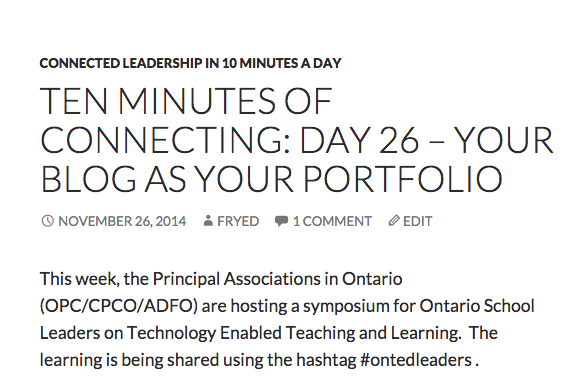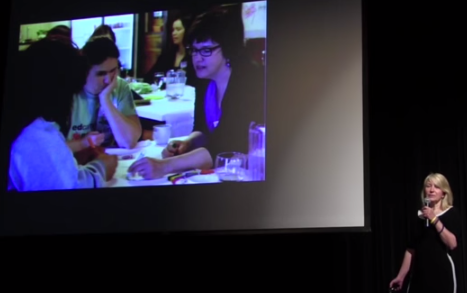It won’t surprise anyone that I am a strong proponent of digital professional portfolios. I demonstrate how to create them here, and over the past year, George Couros has worked with Principal Associations in Ontario (CPCO/OPC/ADFO) to help our school leaders become connected learners, including the idea of using a blog as a portfolio.
I’ve bought into this hook, line and sinker.
I exude visible thinking, open learning, reflective practice, and I promote it in professional practice with every breath.
I know, you’ve heard enough.
So I have to ask, then, if I am wrong? Is it actually a disadvantage to have a digital portfolio?
Because right now, it really feels like it is.
Let me explain.
Over the past three years, I have sat through a number of professional interviews, on both sides of the table. I don’t hear any questions about connected learning, open professional practice, or Professional Learning Networks being asked. Ever.
Never.
I have yet to hear a single question about how an interviewee models the learning we want to see in the classroom.
I have never heard a question about whether the interviewee blogs or sees any value in blogging.
I have not heard a whisper of any competencies around modern learning or 21C practices.
As the person being interviewed, I have watched eyes glaze over at the mention of anything digital. Anything.
What’s going on here? I hear everywhere how TELT (Technology Enabled Learning and Teaching) is a priority in this province, how the renewed vision for excellence is all about creating global citizens and digital leaders for this changing world.
And we are doing this – very well in fact. We have absolutely amazing learning happening in schools. Teachers in Ontario are world leaders in modern pedagogical practice. We KNOW what TELT looks like at the level of the student desk because that is what we are doing every single day as we connect and share and challenge each other to keep getting better at it.
Teachers are flocking to edcamps and Twitter chats, taking charge of their own professional learning and busting out of the model that says learning has to be provided and into the culture where learning is sought.
Educators are flattening the organization. Principals are not “instructional leaders” any more, they are co-learners, because the real learning at all levels is happening where the students are learning, not in a banquet hall in a Toronto hotel.
This is absolutely the most exciting time to be in education. The shift is palpable and visible in classrooms.
When we think about spreading excellence and adapting best practices, we need to stop thinking exclusively about horizontal spread.
How do we spread digital leadership, open reflective practice, networked learning and the modelling of 21C (modern learning) competencies vertically in our education system?
Until we can do that, Digital Portfolios will continue to be invisible.


Reblogged this on teaching knowledge and creativity.
I absolutely agree, Donna. For example, very few of my colleagues ever refer to my blog. It’s weird. Why do you think this phenomenon exists as you describe it?
I think a lot about this question.
I see a similarity with how our 4U (grade 12) students are products of a system and expect to read/memorize/write tests and get good marks. They have learned to play a game, and when we try to put learning first, they and their parents may revolt!
Those winning at the game have the most to lose when the game changes.
I think that our leaders are products of a system that relies on traditional pathways and supports. Few of those involve modern learning. My experience with SOQP qualifications was “lip-service” to modern learning (the mention that we might want to read, “A Rich Seam”). Hiring practices involve paper resumes and letters, possibly sent by email. Interviews involve standard questions. It’s how things are done.
The question is, how do we make the process safe and open to change for those who aren’t part of the change? How do we effect change in positions of responsibility as all the structures that have served these folks so well shift away from what they know and believe in?
How do we truly make modern learning a priority in the entire public education system?
My experiences with the PQP reflects yours. I also see that the next generation of leaders are not connected at all; in fact, it’s almost a point of pride. The sense I am left with after having been in courses with 30 somethings is that it is unreasonable for teachers to be online with other professionals and that it is not a good use of time. That message is so prevalent that the few of us who are connected don’t even mention it. (They all do use Twitter etc to communicate with parents or recognize that that is something they should do; it’s not used professionally.)
Personally, I have educator friends around the province who are certainly future leadership candidates who don’t own a smart phone, are not online in anyway with their colleagues. Here again, that time, the time to blog, to read, to share, to tweet is not viewed as a good use of time.
I feel the tide has shifted–it used to that those not yet online professionally were apologetic. No longer. Now I feel that I am the one who needs to justify that practice.
Your point about never hearing questions regarding connected teaching and learning should be a scandal. We should be offended when folks do not see just how much having a network of professionals who support us is vital to our ability to lead. While I too have not experienced this from the “interview” side of things, I have started to see it in other ways.
We have had a Twitter backchannel at our largest district events, where principals and teachers are expected to post something about their school or their personal experiences. We have supported unconferences for our district, in which more teachers and leaders have taken part than ever before. We have started working with many different departments to ensure that digital badges are a part of the professional learning discussion.
It isn’t fast enough, but the way in which change happens in education isn’t necessarily by starting with established processes, like interviews. It will start (or continue) on the fringes. It will happen all around the most promising work, and it will build on top of all of the connected teachers and leaders. Those that create these portfolios are those that will have the transferable skills. As an example of how this type of portfolio does help folks, this is what I made to show the power of my network: http://bit.ly/1vA9TI1 (I’m not sure it got me the Director of Blended Learning job, but it definitely didn’t hurt.)
P.S. This comment is a part of the #C4C15 project. Find out more here: http://bit.ly/C4C15
Donna, my experiences seem to be so different to the ones that you describe here (and even different than many of those discussed in the comments). While I’ve interviewed for many jobs and have not been directly asked about my “technology and 21st century learning experiences,” many administrators seem to know me already because of what I share online. Many teachers also know me because of this. I often forget that. This year, I moved to a school where I really only knew one teacher on staff, but most of the staff already knew me because of Google. I guess that this can be good or this can be bad (sometimes I wish that people could get to know me first instead of knowing the online me), but it’s a good lesson in digital citizenship, and it is my present reality. And in many ways, it’s been beneficial for me too: my social media presence has given me opportunities that I wouldn’t have had before if it weren’t for that. While I may also not be asked about my use of technology or 21st century learning practices, I always work this into my interview, and I’ve received positive feedback from doing so. Maybe that’s because of our Board’s TLE initiative (Transforming Learning Everywhere) or maybe that’s because of areas of focus in the schools where I applied. Either way, I think that my blogging and tweeting have benefitted me, even if not necessarily being asked about.
Aviva
P.S. I also know all of the principals, vice principals, and superintendents in our Board that blog, and I read and comment on these posts regularly. This gives me great insight into different viewpoints and various perspectives, and I think that’s important. (I wish more would blog!) I also know many other teachers that read these blogs. Maybe the impact of these posts are greater than people realize!
Reblogged this on Teaching in the NOW Century.